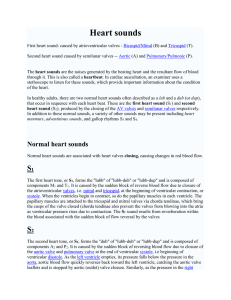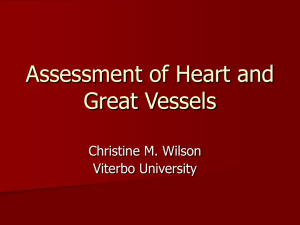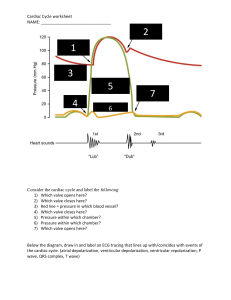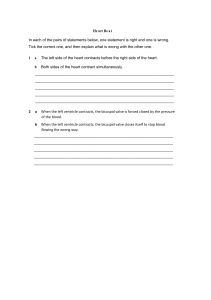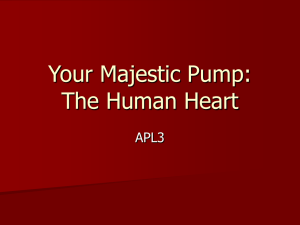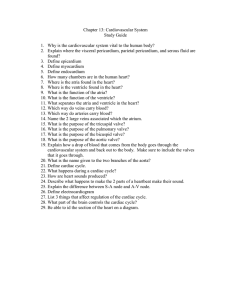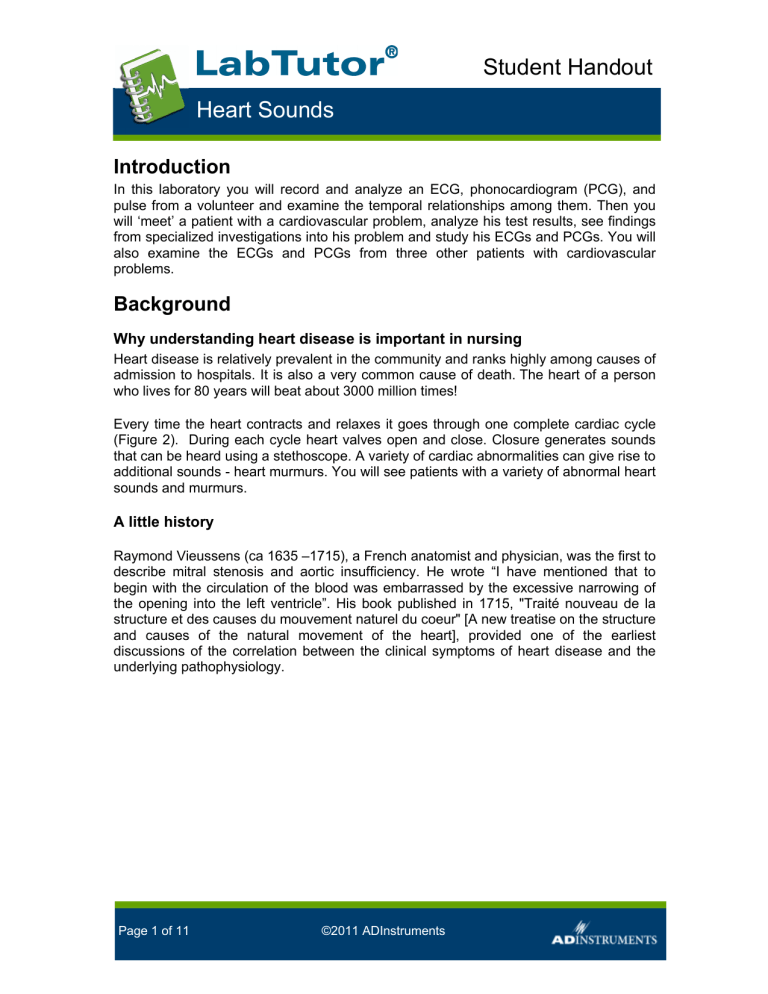
Student Handout Heart Sounds Introduction In this laboratory you will record and analyze an ECG, phonocardiogram (PCG), and pulse from a volunteer and examine the temporal relationships among them. Then you will ‘meet’ a patient with a cardiovascular problem, analyze his test results, see findings from specialized investigations into his problem and study his ECGs and PCGs. You will also examine the ECGs and PCGs from three other patients with cardiovascular problems. Background Why understanding heart disease is important in nursing Heart disease is relatively prevalent in the community and ranks highly among causes of admission to hospitals. It is also a very common cause of death. The heart of a person who lives for 80 years will beat about 3000 million times! Every time the heart contracts and relaxes it goes through one complete cardiac cycle (Figure 2). During each cycle heart valves open and close. Closure generates sounds that can be heard using a stethoscope. A variety of cardiac abnormalities can give rise to additional sounds - heart murmurs. You will see patients with a variety of abnormal heart sounds and murmurs. A little history Raymond Vieussens (ca 1635 –1715), a French anatomist and physician, was the first to describe mitral stenosis and aortic insufficiency. He wrote “I have mentioned that to begin with the circulation of the blood was embarrassed by the excessive narrowing of the opening into the left ventricle”. His book published in 1715, "Traité nouveau de la structure et des causes du mouvement naturel du coeur" [A new treatise on the structure and causes of the natural movement of the heart], provided one of the earliest discussions of the correlation between the clinical symptoms of heart disease and the underlying pathophysiology. Page 1 of 11 ©2011 ADInstruments Student Handout Heart Sounds Raymond Vieussens (ca 1635 –1715) The first illustration of mitral stenosis. From Raymond Vieussens book published 1715. What the heart does The heart is a dual pump that circulates blood around the body and through the lungs. Blood enters the atrial chambers of the heart at a low pressure and leaves the ventricles at a higher pressure. The high arterial pressure provides the energy to force blood through the circulatory system. Figure 1 shows a schematic of the organization of the human heart and the circulatory system. Blood returning from the body arrives at the right side of the heart and is pumped through the lungs. Oxygen is picked up and carbon dioxide is released. This oxygenated blood then arrives at the left side of the heart, from where it is pumped back to the body. Heart valves and heart sounds Each side of the heart is provided with two valves, which convert the rhythmic contractions into a unidirectional pumping. The valves close automatically whenever there is a pressure difference across the valve that would cause backflow of blood. Closure gives rise to audible vibrations (heart sounds). Atrioventricular (AV) valves between the atrium and ventricle on each side of the heart prevent backflow from ventricle to atrium. Semilunar valves are located between the ventricle and the artery on Page 2 of 11 ©2011 ADInstruments Student Handout Heart Sounds each side of the heart, and prevent backflow of blood from the aorta and pulmonary artery into the respective ventricle. Figure 1. A schematic diagram of the human heart and circulatory system. The closure of these valves is responsible for the characteristic sound produced by the heart is usually referred to as a 'lub-dub' sound. The lower-pitched 'lub' sound occurs during the early phase of ventricular contraction. This is produced by closing of the atrioventricular (mitral and tricuspid) valves. These valves prevent blood from flowing back into the atria. When the ventricles relax, the blood pressure drops below that in the artery, and the semilunar valves (aortic and pulmonary) close, producing the higherpitched 'dub' sound. Malfunctions of these valves often produce an audible murmur, which can be detected with a stethoscope. The cardiac cycle The sequence of events in the heart during one cardiac cycle is summarized in Figure 2. During ventricular diastole blood is returning to the heart. Deoxygenated blood from the periphery enters the right atrium and flows into the right ventricle through its open AV valve. Oxygenated blood from the lungs enters the left atrium and flows into the left ventricle through its open AV valve. Filling of the ventricles is completed when the atria contract (atrial systole). In the resting state, atrial systole accounts for some 20% of ventricle filling. Atrial contraction is followed by contraction of the ventricles (ventricular systole). Initially, as the ventricles begin to contract the pressure in them rises and exceeds that in the atria. This closes the AV valves. But, until the pressure in the left ventricle exceeds that in the aorta (and in the right ventricle exceeds that in the pulmonary artery), the volume of the ventricles can not change. This is the so-called isovolumic phase of ventricular contraction. Finally, when the pressure in the left ventricle exceeds that in the aorta (and the pressure in the right ventricle exceeds that in the pulmonary artery), the aortic and pulmonary valves open and blood is ejected into Page 3 of 11 ©2011 ADInstruments Student Handout Heart Sounds the aorta and pulmonary arteries. As the ventricular muscle relaxes, pressures in the ventricles fall below those in the aorta and pulmonary artery, and the aortic and pulmonary valves close. Ventricular pressure continues to fall and once it has fallen below that in the atria, the AV valves open and ventricular filling begins again. Figure 2. A schematic diagram of cardiac cycle. The electrical activity of the heart Cardiac contractions are not dependent upon a nerve supply. However, innervation by the parasympathetic (vagus) and sympathetic nerves does modify the basic cardiac rhythm. Thus the central nervous system can affect this rhythm. The best known example of this is so-called sinus arrhythmia where respiratory activity affects the heart rate. A group of specialized muscle cells, the sinoatrial, or sinuatrial (SA) node acts as the pacemaker for the heart (Figure 3). These cells rhythmically produce action potentials that spread through the muscle fibers of the atria. The resulting contraction pushes blood into the ventricles. The only electrical connection between the atria and the ventricles is via the atrioventricular (AV) node. The action potential spreads slowly through the AV node, thus allowing atrial contraction to contribute to ventricular filling, and then rapidly through the AV bundle and Purkinje fibers to excite both ventricles. Page 4 of 11 ©2011 ADInstruments Student Handout Heart Sounds Figure 3. Components of the human heart involved in conduction. The cardiac cycle involves a sequential contraction of the atria and the ventricles. The combined electrical activity of the different myocardial cells produces electrical currents that spread through the body fluids. These currents are large enough to be detected by recording electrodes placed on the skin (Figure 4). A recording of this electrical activity is an electrocardiogram (ECG). Figure 4. Standard method for connecting the electrodes to a volunteer. Page 5 of 11 ©2012 ADInstruments Student Handout Heart Sounds The regular pattern of peaks during one cardiac cycle is shown in Figure 5. Figure 5. One cardiac cycle showing the P wave, QRS complex and T wave. The action potentials recorded from atrial and ventricular fibers are different from those recorded from nerves and skeletal muscle. The cardiac action potential is composed of three phases: a rapid depolarization, a plateau depolarization (which is very obvious in ventricular fibers) and a repolarization back to resting membrane potential (Figure 5). Figure 6. A typical ventricular muscle action potential. The components of the ECG can be correlated with the electrical activity of the atrial and ventricular muscle: • The P-wave is produced by atrial depolarization. • The QRS complex is produced by ventricular depolarization; atrial repolarization also occurs during this time, but its contribution is insignificant. • The T-wave is produced by ventricular repolarization. Page 6 of 11 ©2012 ADInstruments Student Handout Heart Sounds Wiggers Diagrams Changes in a variety of parameters during one cardiac cycle are usefully summarized in a figure introduced by Wiggers. A modified form of this is shown in Figure 7. The importance of this representation is that it allows you to see the temporal relationships between the different parameters. Figure 7. A Wiggers' diagram. Page 7 of 11 ©2012 ADInstruments Student Handout Heart Sounds Valvular Heart Disease In this Laboratory, you will examine recordings from patients with 4 common valvular heart lesions - mitral stenosis and incompetence (regurgitation, insufficiency) and aortic stenosis and incompetence (regurgitation, insufficiency). By listening to the heart, it is possible to decide which of these conditions is present. In this laboratory, you will see the heart sounds recorded at the same time as the patient's ECG. This enables you to determine the timings of the heart sounds and murmurs accurately in relation to the cardiac cycle. Mitral Valve Mitral Stenosis In mitral stenosis, there is a narrowing of the orifice of the mitral valve. Blood flows from left atrium to left ventricle through this valve during ventricular diastole. With mitral stenosis, a low pitched, mid-diastolic murmur is heard. There is often a louder than normal first sound as the mitral valve is shut more forcibly than normal. Mitral Insufficiency In mitral Insufficiency, damage to the valve structure leads to a leak of blood back from the contracting ventricle to the left atrium. This leak results in a high-pitched murmur heard throughout systole. Because of the greater blood volume in the left atrium, there is a very rapid filling of the left ventricle when the mitral valve opens in early diastole. This gives rise to a 3rd heart sound. Aortic Valve Aortic Stenosis In aortic stenosis, a narrowed aortic valve impedes blood flow into the aorta during ventricular systole. This results in a characteristic systolic murmur that increases in loudness to mid-systole and then fades gradually. The second heart sound may be softer than normal, too. Aortic Insufficiency In aortic insufficiency, the defective valve does not close properly so that, during early diastole, blood flows back into the ventricle. This results in an early diastolic murmur that follows the second heart sound and gradually decreases in intensity. Page 8 of 11 ©2012 ADInstruments Student Handout Heart Sounds Treating patients with heart conditions Treating heart conditions often requires multiple medications. These can include; • Angiotensin-converting enzyme (ACE) inhibitors. These agents are used to treat hypertension and heart failure. By inhibiting ACE, arteriolar resistance is decreased. ACE inhibitors can be identified by the suffix '-pril' and common ACE inhibitors are captopril, benazepril, lisinopril, cilazapril and enalapril. Potential side effects with these drugs include cough, headache, drowsiness, hypotension, rash and renal failure. • Antiarrhythmic agents. This large class of drugs includes agents that suppress cardiac arrhythmias through a variety of mechanisms, including β-adrenoceptor antagonism and calcium, sodium and potassium channel blocking. Examples of antiarrhythmic agents are quinidine, lidocaine, propranolol, amiodarone, verapamil and digoxin. Drug interactions can occur between amiodarone and warfarin, and also between amiodarone, quinidine and propafenone and digoxin. Amiodarone can also cause skin appear blue-grey in color. • Anticoagulants. These agents are used to reduce the risk of blood clots leading to heart attacks or strokes, and can also be prescribed if a patient has undergone heart valve replacement. Warfarin is a common anticoagulant, but its use must be monitored carefully due to numerous interactions with other drugs, including aspirin and certain diuretics, antibiotics, fibrates, and antiarrhythmia medications, cranberry products and grapefruit juice. Patients on anticoagulant medication should also avoid excessive consumption of green, leafy vegetables, as this will reduce the drug's effects. • Antiplatelet agents. Antiplatelet drugs are considered better at preventing arterial clots than anticoagulants. They work by reducing platelet aggregation and inhibiting thrombus formation. Examples of antiplatelet drugs are acetylsalicylic acid (aspirin), clopidogrel, dipyridamole and ticlopidine. Because antiplatelet medications can cause gastrointestinal upset (nausea, stomach pain, diarrhea), it is recommended that these agents been taken with food. Also, antiplatelets increase the risk of bleeding, which should be considered in patients who may require surgery. • β-adrenoceptor antagonists (also known as beta blockers). These are drugs that inhibit the action of epinephrine and norepinephrine to reduce cardiac output and blood pressure. Unwanted side effects of β-adrenoceptor antagonists are dry mouth and skin, bronchoconstriction, bradycardia and hypoglycaemia. Some βadrenoceptor antagonists may interact with diabetes and asthma medicines. • Calcium channel blockers. This class of drugs slows down the electrical conductivity of the heart, leading to a lower heart rate and reduced blood pressure. Some examples of calcium channel blockers are verapamil, diltiazem, amlodipine and nifedipine. Page 9 of 11 ©2012 ADInstruments Student Handout Heart Sounds • Cholesterol-lowering medications. These agents include statins, resins, nicotinic acid, fibrates and cholesterol absorption inhibitors. These drugs reduce cholesterol synthesis, increase bile synthesis (which uses cholesterol), reduce triglyceride levels, or block cholesterol absorption from food. The end result is less cholesterol in the bloodstream. Gastrointestinal upsets (nausea, diarrhea, vomiting, constipation), headaches and arrhythmia are common side effects with this class of drugs. Drug interactions have been noted for warfarin, erythromycin and cholesterol-lowering medications. • Diuretics. Diuretics are often used in patients with high blood pressure. By promoting the kidneys to remove excess salt and fluid from the blood, blood pressure is lowered. They are also useful in treating edema. Possible side effects of diuretics include weakness, muscle cramps, rash, gastrointestinal upset, dizziness, and increased sensitivity to sunlight. Furthermore, diuretics should not be used in combination with digoxin or digitalis, cyclosporine or other medications for high blood pressure. • Nitrates. Nitrates act as vasodilators and are used to treat chest pain. Nitrates may be administered orally in the form of a pill, lozenge or translingual spray, in a topical ointment, or skin patch. Common side effects with these agents are dizziness, headaches, gastrointestinal upset, low blood pressure and arrhythmia. Drug interactions have been noted with erectile dysfunction medications, cold and flu medications and with high blood pressure treatments. Other important aspects of caring for patients with heart conditions include dietary, smoking and exercise interventions. Page 10 of 11 ©2012 ADInstruments Student Handout Heart Sounds What you will do in the class In this class you will perform three exercises and examine one case study. 1. Heart sounds. You will begin by using a stethoscope to listen to the heart. 2. ECG and PCG in a resting volunteer. You will record the ECG and PCG of a volunteer at rest, then analyze the signals. 3. ECG, PCG, and pulse. You will record and analyze the ECG, PCG, and pulse of a volunteer. Patient Case Study: You will ‘meet’ Mr H, a patient with a heart murmur, and use the results of investigations into his problem to develop a Nursing diagnosis and patient care plan. Three supplementary patient cases are also provided for further study. References Bray J., Cragg P. A., Macknight A., Mills R., Taylor D. Lecture Notes: Human Physiology 5th Edition, edited by Petersen O.H. (Blackwell Publishing, 2007) Rang H.P., Dale M.M., Ritter J. M. Pharmacology 6th Edition (Elsevier Science, 2007) Page 11 of 11 ©2012 ADInstruments

